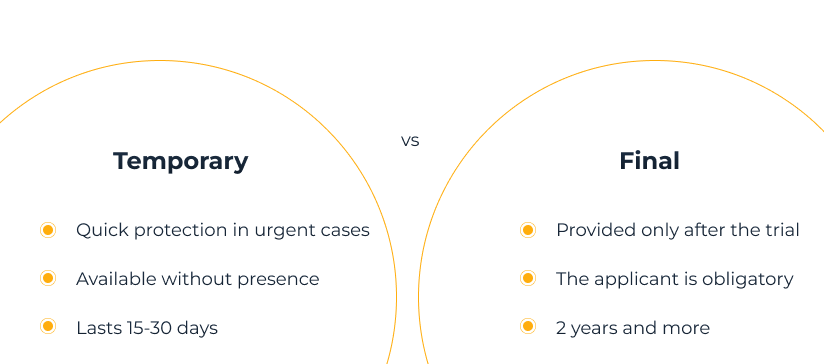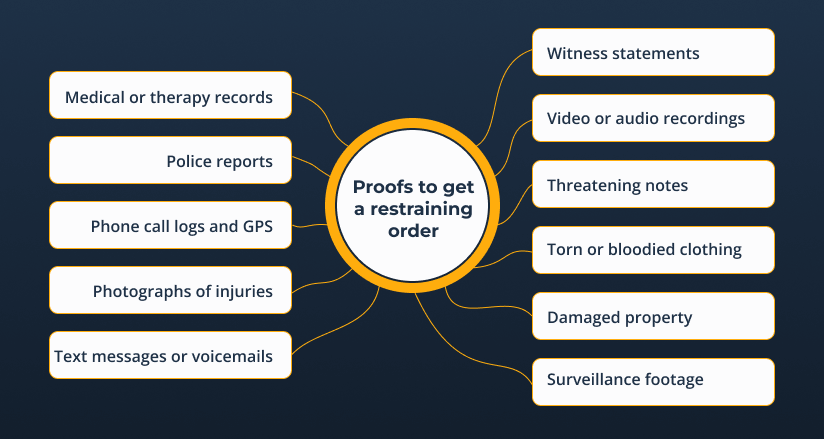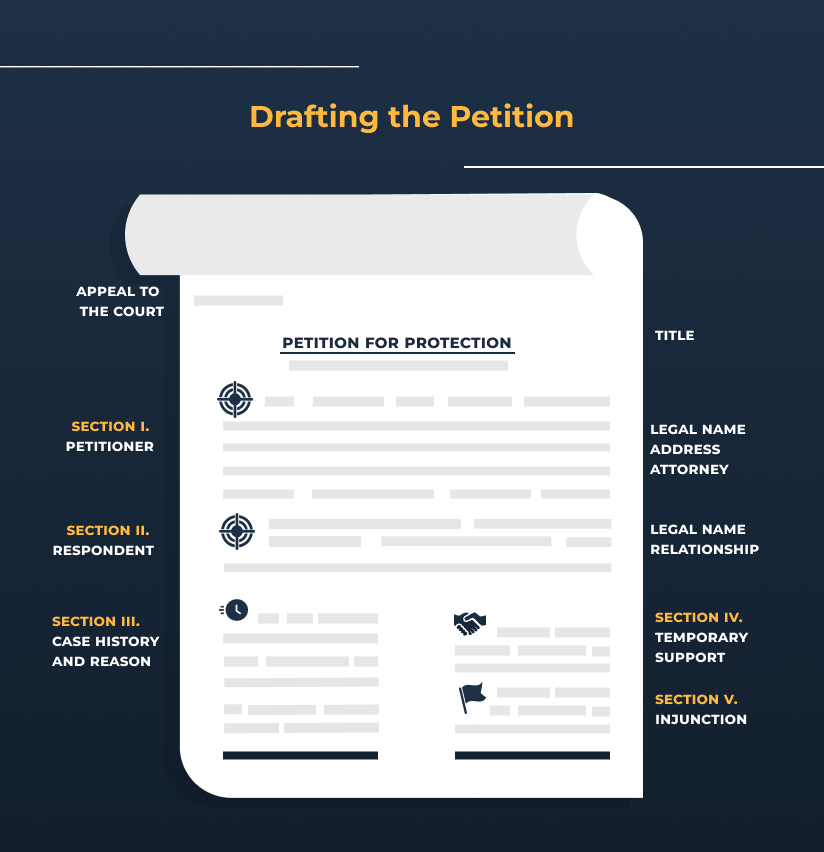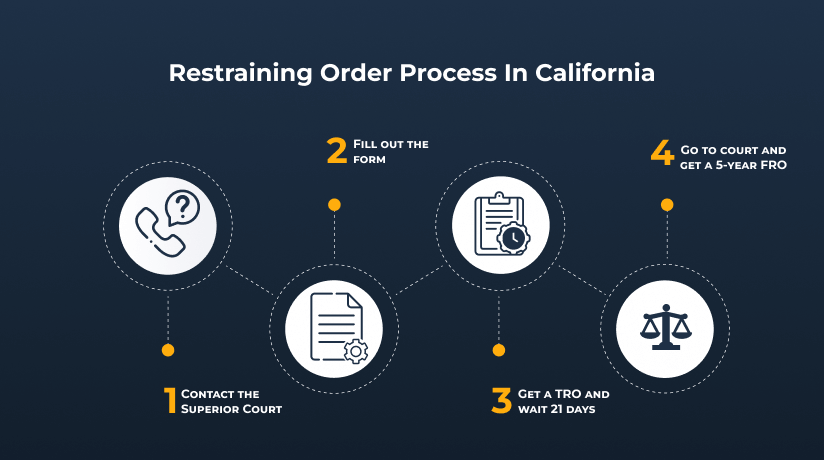
When your safety teeters on the brink, a restraining order emerges as one of the most decisive shields against potential harm. But desiring protection doesn’t secure it.
For example, in 2021, the U.S. saw 910,880 domestic violence cases. But only 48.9% reached the police which is one of the best proofs for a restraining order to ensure your safety.
Let’s find out what is it and do you need evidence for a restraining order.

The context of restraining orders isn’t one-dimensional. Keep reading to learn about restraining order meaning and its types.
A restraining order is a legal measure designed to protect an individual from potential harm by another. Imposing limits on the threatening party’s actions and behaviors ensures the safety of those at risk.
The key here is restraining order proof. The courts must clear evidence that demonstrates the necessity of such an order. And this necessity isn’t rooted in actual harm—it can stem from the threat of harm, harassment, or even intimidating behavior.
For example, in 2022, Connecticut recorded 8,255 restraining order cases: 4,765 were urgent and 3,490 followed a court hearing. In one state, we see these numbers; imagine the hundreds of thousands nationwide. Restraining orders serve as a common safety measure.

A restraining order tailors protection to specific threats. Let’s break down the types:
Roughly 41% of women and 26% of men have endured sexual violence, physical harm, or stalking by a partner. Common consequences include injuries, PTSD, emotional distress, safety concerns, and missed workdays.
Can you get a restraining order for no reason? No. Courts demand credible reasons, like harassment or abuse, before granting such orders. It’s about genuine protection, not baseless claims.
Time is often of the essence. Trying to decide when to get a restraining order, and knowing your options can empower you. Here’s a concise breakdown:

Temporary Injunctions:
Final Injunctions:
Temporary injunctions provide quick relief, often issued ex parte (without notifying the other party). But, final injunctions come at a case’s end, providing lasting relief after both parties present their case.
In essence, reasons for a restraining order vary, but your safety always takes precedence. Temporary buys time, while final solidifies protection. Both ensure you’re not walking alone.

And check out our article “What is OVI in Ohio? An Easy Guide to OVI Charges“.
Now let’s take a look at how hard it is to get a restraining order and whether it is so.
Building a robust case for a restraining order hinges on concrete evidence. Not sure about what type of proof you need to support a restraining order? Here’s how to document incidents:

1. Direct Evidence:
Statistics show that only 50.7% of violence victims report their partner’s abuse to the police. Remember, police reports provide strong evidence of abuse.
2. Circumstantial Evidence:
Melding varied evidence brings clarity, especially when highlighting consistent behavior causing distress. The broader and more solid your evidence, the mightier your case stands.
For example, if you’re a victim of blackmail, note the time, sequence, and texts. Ideally, record the conversation. Keep evidence copies and inform the police. Just your word might not suffice.
Your petition isn’t just a request — it’s a formal plea to the court underlining the gravity of your situation. Here’s what you should consider:

Pro Tips:
Can you get a restraining order without proof? Courts demand concrete evidence to grant a restraining order. While procedures vary by region, pursuing one without a valid basis can expose you to potential legal repercussions.
Attending the restraining order hearing is your moment to confirm your need for protection. Here’s how to ace it:
Think how to win a restraining order hearing – stick to hard facts and sidestep emotional hyperbole.
Learn more about “Can You Get a DUI on a Bike? Navigating Legal Boundaries“.
Let’s take a closer look at what do you need to get a restraining order depending on your state.

What proof do you need for a restraining order in Florida? In this state, seeking an injunction for protection requires proving a credible, imminent threat of violence. Various injunctions cover domestic violence, repeat offenses, dating, and sexual violence.
Under Florida Statute 741.31, violating a domestic violence injunction is a crime. Ensure your relationship with the respondent fits the state’s “household member” definition.
Use Florida’s Form 12.980 to detail your case, and note that domestic violence injunctions are fee-free, but photo ID is essential.
In Texas, restraining orders come in 3 flavors: emergency, temporary ex parte, and final.
Curious about how much is a restraining order? In Texas, it’s free through the DA’s office.
But, breach these orders? The defendant faces a Class A misdemeanor, which means up to a year in prison and a $4,000 fine.
Head to the Superior Court for the necessary forms. After a quick review, a judge may issue a Temporary Restraining Order (TRO) ahead of a hearing set 21 days later.
While TROs are short-term, restraining orders can shield you for up to 5 years. On an urgent note, police can provide an Emergency Protective Order lasting up to 7 days.

And a heads up: breaking these orders is a criminal act under California Penal Code 273.6 PC.
Do you need proof for a restraining order in California? The victim’s testimony about immediate threats suffices, and extensive evidence isn’t necessary. But, for a final order, concrete evidence is crucial.
How much does a restraining order cost in California? Filing an emergency protective order is free. But, without claims of violence, stalking, threats, or a fee waiver request, expect to pay $395-$450 for your forms.
In Georgia, to get a restraining order:
Note: Georgia’s orders have limits. Temporary orders last up to 30 days or until the hearing, but you can extend them. Renew before the end for longer protection.
In Illinois, an Order of Protection recognizes various abuse forms:
Harassment includes actions like workplace disturbances or relentless following. Dependents witnessing abuse can interpret it as “intimidation”. Willful deprivation means denying essentials like medication or shelter to a vulnerable person.
If you’re seeking extra relief, you need to provide findings and corroborating evidence that the relief is necessary. The court must document specific reasons for granting protection.
How to fight an order of protection in Illinois?
To contest a protection order:

Check out our article “Bond vs Bail: Key Distinctions in the Legal Process“
Remember: Even after an emergency order, you can state your case in court. Always follow court orders to prevent further legal issues. The authorities can prevent a person from contacting the victim or entering a house for at least 72 hours. If someone breaks an order of protection, the law classifies it as a Class A misdemeanor, carrying a jail sentence of up to 364 days.
In South Carolina, to seek a restraining order:
The order lasts six months, with options to renew by contacting the issuing Court.
For an emergency temporary restraining order (ETRO), present evidence like recent threats or violent acts. To get a temporary restraining order (TRO), show a genuine fear due to the respondent’s behavior. For a long-term protective order, provide evidence like incident histories, medical records, photos, or communication records that prove abuse.
Hearings under the Domestic Abuse Assistance Act take place within 20 days of filing. For the Louisiana Code of Civil Procedure 3601, they occur within 10 days.
How do I fight a restraining order in Louisiana?
Start by collecting evidence and building a solid defense with your attorney. Use texts, emails, or witness accounts that show there’s no threat or harassment from your side. Your lawyer can challenge the petitioner’s claims, cross-examine their witnesses, and raise any rights violations during the restraining order process.
Violating a protective order in Louisiana carries penalties:
If you have prior convictions for violating protective orders or related offenses, the penalties may be more severe.
Arizona requires evidence of harassment, assault, or domestic violence. This could be medical records showing injuries, police reports, or medical evaluations. To get this order, you must have a familial link with the defendant, such as ex-spouses, roommates, or blood relatives.
For non-familial cases, consider an Injunction Against Harassment:
You can file a petition against harassment with any judicial officer, be it a magistrate, justice of the peace, or superior court judge.
Alabama
Protection Order
Permanent
Alaska
Protective Order
1 year
Arizona
Injunction Against Harassment
1 year
Arkansas
-
90 days – 10 years
Califonia
Injunction Against Harassment
5 years
Colorado
Civil Protection Order
Permanent
Connecticut
Order of Protection
1 year
Delaware
-
1-2 years
Florida
Injunction for Protection Against Domestic Violence
Permanent
Georgia
Protection Order
1 year
Illinous
Plenary Order of Protection
2 years
Indiana
-
2 years
Iowa
-
1 year
Kansas
Protective Order
1 year
Kentucky
-
3 years
Louisiana
Protection Order
18 months
Maine
Protection Order
2 years
Massachusetts
Protection Order
1 year
Michigan
Personal Protection Order
No less than 182 days
Minnesota
Order for Protection
2 years
Missouri
-
180 days - 1 year
Montana
-
Permanent
New Jersey
-
Permanent
New York
-
2-5 years
Ohio
-
5 years
Texas
-
2 years and more
Washington
-
1 year or permanent
For legal issues in other states, please contact an experienced criminal defense attorney for individualized advice.
Obtaining a restraining order is a potent way to shield yourself from imminent threats and ensure personal safety. But, the process, though designed for protection, demands meticulous preparation. Considering professional help what proof do you need for a restraining order? Family law or domestic violence attorneys can streamline the journey. They decode legal intricacies, help join evidence, and bolster your courtroom presence.
Seeking legal help not only sharpens your case but also ensures you’re not navigating the tumult alone. If you’re facing accusations of violating a protective order or thinking about filing one, contact us for personalized advice and guidance tailored to your needs.
Securing a temporary order is easy. Plus, there’s no fee. But, a trial and concrete evidence are necessary to grant a final restraining order. Merely citing “security concerns” isn’t enough.
The individual seeking protection must prove they have a reasonable belief that they are being abused. This can range from documented incidents of harassment to electronic records and more.
Yes, once granted, a restraining order becomes a public record. But, specifics like the reasons for the order or the evidence provided remain confidential.
Yes, you can get a restraining order against cyberstalking, but you must provide clear evidence and proof of the threat. Courts issue restraining orders against family members or intimate partners involved in harassment. These can last up to 5 years in certain cases.










